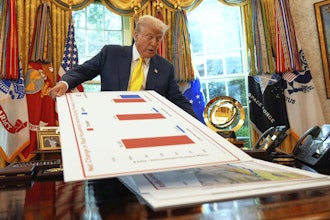(THE CONVERSATION) President Donald Trump recently said he was open to returning to the Trans-Pacific Partnership, but only if he could get a “substantially better” deal than his predecessor.
This apparent change of heart, announced via Twitter, caught most observers off guard. The TPP was on track to become the world’s largest free trade zone by joining Pacific Rim countries that collectively produce about 40 percent of global economic output. But Trump railed against the accord on the campaign trail, making it the ultimate bugbear for his brand of economic nationalism. In a widely anticipated move, he withdrew the U.S. from the TPP as one of his first presidential acts.
If Trump ever officially changed his tune and tried to rejoin this trade pact, could he?
Like many observers, I believe it would be tough to pull off. The other 11 countries would clearly prefer to have the U.S. in rather than out, but they are understandably reluctant to throw open, for a third time, negotiations that took years to conclude.
Backstory
In 2008, most of the major Pacific Rim economies – with the notable exception of China – began to consider a massive free trade agreement for the region.
Formal TPP talks finally began two years later, when representatives of the U.S. and several other Pacific nations, such as Australia, Chile and Vietnam, started to hammer out the pact’s contentious details.
The deal, which took another six years to complete, later expanded to include more countries – including Japan, Canada and Mexico.
The aim of the TPP was to deepen economic ties between the dozen countries, slash tariffs on a broad range of goods and services, and better synchronize their policies and regulations. The substance of the agreement was complex, and different countries negotiated different grace periods for its implementation.
TPP proponents like me based our support on well-established economic theories, which point to the benefits of barrier-free trade for all participating countries. These theories do not deny, of course, that some industries and workers can suffer significantly from open exchange. But they emphasize the overall advantages of freer trade in generating new jobs, cheaper products and more innovation.
Another argument in favor of the accord was more geopolitical, considering the TPP as a bulwark against China – which was never slated to join.
Despite its potential benefits, however, the emerging partnership soon became a lightning rod for U.S. opponents of open markets.
Objections
The critics lodged three distinct complaints. They expressed skepticism for the benefits of free trade itself, arguing that imports can destroy industries, uproot communities and threaten national security. They also argued that international agreements undermine democracy and objected to the secrecy of the negotiations themselves.
Finally, opponents homed in on the pact’s specific details, especially those that were leaked or released early on. The most controversial issues proved to be indirectly related to trade policy.
TPP foes, for example, lambasted provisions regarding intellectual property, labor and the environment. Some critics argued that these rules went too far, while others complained that they didn’t go far enough.
Many of them also vehemently opposed its investor-state dispute settlement provisions, which would have let foreign businesses sue member governments for any violations that they claimed were hurting their interests.
Despite this opposition in the U.S and elsewhere, the 12 nations ultimately signed the TPP in February 2016 and began the process of domestic ratification. But Trump was elected later that year, and he backed out of the deal as soon as he entered the White House.
Most observers expected America’s exit to doom the agreement. Instead, the 11 remaining signatories forged a smaller pactamong themselves, renamed the Comprehensive and Progressive Agreement for Trans-Pacific Partnership and signed in March 2018. Lawmakers in the countries taking part are now considering ratification.
Another flip-flop
Besides, this bout of Trump’s apparent openness to join the TPP seemed to be short-lived. It may have ended as it started, on Twitter. The pact would have “too many contingencies and no way to get out if it doesn’t work,” Trump said in a tweet that mischaracterized South Korea as a member. (It isn’t.)
Perhaps Trump realized that the U.S. would probably have to accept terms that are no better – and possibly worse – than those President Barack Obama agreed upon in 2016 when the TPP talks ended.
This article was originally published on The Conversation. Read the original article here: https://theconversation.com/what-is-the-tpp-and-can-the-us-get-back-in-95028.






















